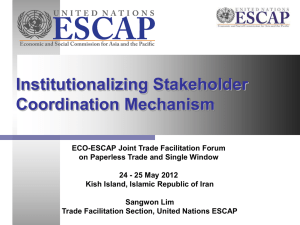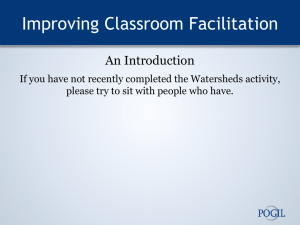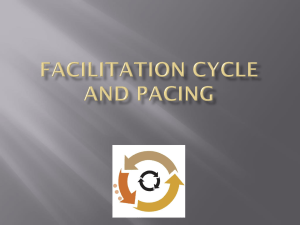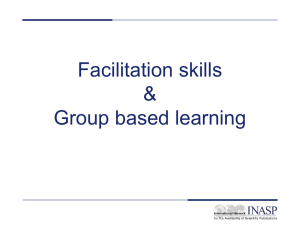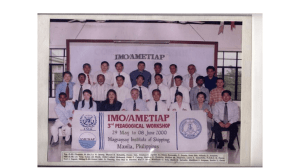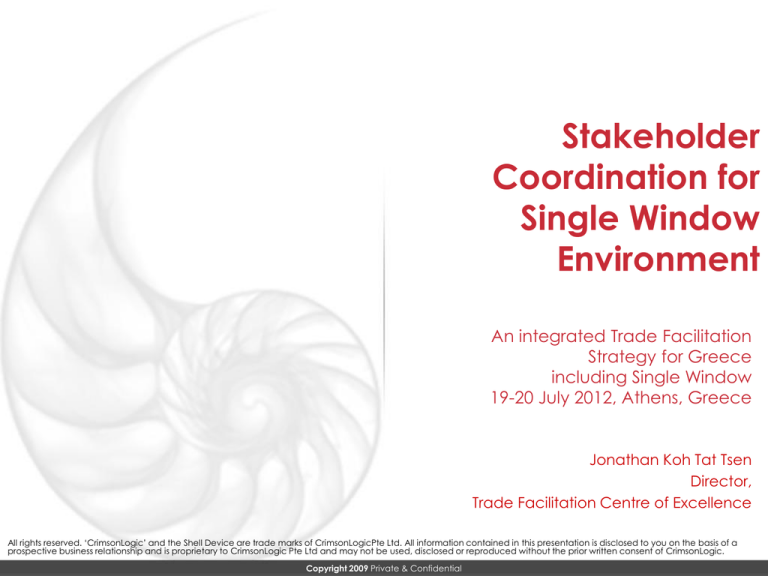
Stakeholder
Coordination for
Single Window
Environment
An integrated Trade Facilitation
Strategy for Greece
including Single Window
19-20 July 2012, Athens, Greece
Jonathan Koh Tat Tsen
Director,
Trade Facilitation Centre of Excellence
All rights reserved. ‘CrimsonLogic’ and the Shell Device are trade marks of CrimsonLogicPte Ltd. All information contained in this presentation is disclosed to you on the basis of a
prospective business relationship and is proprietary to CrimsonLogic Pte Ltd and may not be used, disclosed or reproduced without the prior written consent of CrimsonLogic.
Copyright 2009 Private & Confidential
Institutionalizing
Stakeholder
Coordination
Mechanism
All rights reserved. ‘CrimsonLogic’ and the Shell Device are trade marks of CrimsonLogicPte Ltd. All information contained in this presentation is disclosed to you on the basis of a
prospective business relationship and is proprietary to CrimsonLogic Pte Ltd and may not be used, disclosed or reproduced without the prior written consent of CrimsonLogic.
When the Family Agrees …..
A family in harmony and accord …..
•
•
•
•
•
•
•
•
Papa
Mama
Mama-in-law
Teenage Daughter
Pre-teen Son
Uncle
Butler
Pet … (Hand)
Copyright 2009 Private & Confidential
Fine Balancing …
Copyright 2009 Private & Confidential
Stakeholder Coordination for Single
Window Environment
Stakeholder coordination in Single Window implementation may
require different approaches depending on country circumstances,
there are six common critical factors, or to-do’s, that should be taken
into account
Set Clear Scope
Facilitate
Inter-Agency
Coordination
Keep
Stakeholders
Engaged
er
hold n
e
k
Sta dinatio
r
Coo for
w
in d o
W
le
nt
Sing ironme
Env
Appoint
Strong Lead
Agency
Build Proper
Communication
Channel
Ensure Political
Commitment
with Strategic
Mandate
Political Commitment & Strategic Mandate
Why political commitment is essential?
Significant investment of human resources and budget :
• Korea – > USD 20 million
• Singapore – > USD 10 million (initial investment)
• Mongolia – > USD 10 million (to be implemented)
Stakeholder engagement and coordination
• 27 to 30 different agencies involved in a trade
• A conflict of interest among stakeholders
Reform of administration process and laws/regulations
• In the development phase of S/W system of Senegal, the
resistance from an agency led the project stand-stil from 1999 to
2002 (UNNExT Brief 5)
Sustainable development and operation
• Without the interest of the top-level, the promotion of the services
may fail
Political Commitment & Strategic Mandate
Political Commitment for Single Window – Case of Singapore
In Singapore, the Government’s commitment to implement the
Single Window (TradeNet) was made in the context of national
strategic mandate at the highest level.
Faced with its first recession in 1985, the Singaporean government
reacted with the establishment of a high-powered Economic
Committee to identify weaknesses and set strategies for improving
economic competitiveness.
Mr. Lee Hsien Loong, then the Minister for Trade and Industry,
presently the Prime Minister, was the driving force of the TradeNet
project.
Strong Leadership
Engagement of Stakeholders
Strong leadership ensures success!!
The Sponsor of Single Windows :
• Korea : Prime Minister
• Singapore : Minister of Trade and Industry
• Vietnam : Minister of Finance
• Mongolia : Minister of Foreign Affairs
Strong Lead Agency
Lead Agencies of Single Window Projects
Country
Lead Agency
Institutional
Mechanism
Thailand
Thailand Customs Department
NCTLD
Vietnam
General Department of Vietnam Customs
National Steering
Committee
Indonesia
Indonesia Customs
INSW Preparation Team
Malaysia
Ministry of International Trade and Industry (MITI)
National Single Window
Committee
Trade Development Board
TradeNet Steering
Commitee
Ministry of Knowledge Economy
e-Trade Facilitation
Center
Kenya Trade Agency
NSWS Steering
Committee
Singapore
Korea (Rep.)
Kenya
Keeping Stakeholders Engaged
•
Formal institutional arrangements should be put in place to facilitate the participation
of all stakeholders in the development of SW- relevant government agencies and
private sector representatives. The participation of the private sector is critical to gain
information from the user perspective
UN/CEFACT Rec. 4 - National Trade Facilitation Committee
“National trade facilitation bodies provide this important forum. Participants in
such bodies should represent all companies and institutions that take part in
international trade transactions: manufacturers, importers, exporters, freight
forwarders, carriers, banks, insurance companies and public administrations,
each with a joint and separate interest in the facilitation of trade. It is only with
the active involvement of these participants that impediments can be analyzed
meaningfully and cooperative solutions devised.”
“A lot of times, people
don’t know what they
want until you show it
to them.”
Steve Jobs, Businessweek, 1998
Copyright 2011 Private & Confidential
Keeping Stakeholders Engaged
TradeNet Structure
TradeNet Steering Committee
Sea Community
Sub-Committee
Air Community
Sub-Committee
Government
Sub-committee
Implementation Team
Integrated Procedures &
Business Processes
Proposal
Copyright 2009 Private & Confidential
Inter-agency Co-ordination
•
As Single Window is a mechanism to integrate services on regulatory
requirements handled by various government agencies, some government
agencies may likely perceive it as a possible threat to their authority over
regulatory processes, and subsequent downsizing of human resources.
•
Having a legal mandate and high-level political commitment would definitely
improve coordination. Still, having an institutional arrangement for inter-agency
collaboration is crucial for dealing with issues of change management. The
following factors should be taken into consideration:
•
First, at the very beginning of SW design, an arrangement in the form of a
national committee can provide a neutral platform for open dialogue.
•
Second, very early-on, relevant government agencies should be made to
understand that SW implementation does not necessarily mean the integration
of all the trade-related regulatory services into one big system. Commonly
found operational model of SW is an interfaced model where relevant
government agencies can have the regulatory services over which they have
a control and maintain cooperative connectivity with a Single Window.
Inter-agency Co-ordination
Case: Inter-agency Coordination Platform of Vietnam
Build Proper Communication
•
A two-way communication channel needs to be established and maintained all
through the planning, design and implementation of the SW.
•
During planning and design stage, proper communication accommodates accurate
collection and integration of stakeholders’ needs and requirements. In development
stage, regular communication provides timely update to the stakeholders on any
change of plan as well as progress made.
•
Commonly deployed communication channels include regular meetings among
primary stakeholders, briefing sessions, public seminars and conferences, public
hearings and other mass media are used for general public and broader scope of
stakeholders. Electronic means such as website, e-newsletter, group email list, etc. are
also frequently practiced.
•
In Kenya, the communication strategy included creating news-worthy events to
publicize the implementation as well as launching public relation activities with the
emphasis on its economic benefits. In Malaysia, success story, awareness programs,
annual user surveys and dialogues were employed.
Case Study: South Korea
Private e-Trade Committee
National e-Trade Committee
Chair : Dr. Jung Uck, Seo
Chair : Prime Minister
Administrative Committee
Chair : Vice Minister of MOCIE
Korea e-Trade Facilitation Center
Platform
W/G
e-TP PM
e-TDR
Law
W/G
Law Reform
Finance
W/G
e-L/C
e-Nego
Logistics
W/G
RFID
e-L/G
e-D/O
Marketing
W/G
e-MP
e-Catalog
Solutions
Global
W/G
e-C/O
e-B/L
APEC,ASEM
Bilateral Networking
Dr. Jung Uck, Seo: Former Minister of Science & Technology and Chairman of Korea e-Business Association
MOCIE: Ministry of Commerce, Industry and Energy, KITA: Korea International Trade Association
KFTC: Korea Financial Telecommunications and Clearings Institute, W/G: Working Group,
e-TP PM: e-Trade Portal Project management, e-TDR: e-Trade Document Repository, e-L/C: e-Letter of Credit,
e-Nego: e-Negotiation, e-L/G: e-Letter of Guarantee, e-D/O: e-Delivery Order, e-MP: e-Market Place
e-C/O: e-Certificate of Origin, e-B/L: e-Bill of Lading
G-to-G Inter-agency Coordination
Consensus on Scope
•
The scope of Single Window to be implemented
If the scope is not clearly defined from the outset, stakeholders may build
different views and expectations on SW since it can be interpreted
differently to different stakeholders.
The view on the scope can be differ by the Single Window environment
and by the stakeholders of each countries
•
Clear implementation scope is at the core of Single Window Master Planning
Sensitive issues such as operation model of S/W, ownership of data in the
S/W system and etc.. can be also covered in the Master Plan
1. Prioritize efforts
2. Find Low Hanging fruits
3. Achieve Quick Wins
4. Breed Success
What are the Imperatives?
• Clear Vision to guide
development and prioritize needs
• Quick Wins to meet immediate
needs and sustain organizational
interests
• Sustained Development to ensure
continued enhancements and
relevance
Short Term – Harnessing low hanging
opportunity
• 9 “low hanging” opportunities to contribute considerable impact to
the trade facilitation,
• can be implemented with short timeframe, incurring lesser effort
and cost (total about $5.5M).
Copyright 2009 Private & Confidential
Mid Term – “Leveraged” opportunities
• The 3 initiatives would also incur a heavier investment totaling
about $3.5M.
• This group of recommendations be considered in near term ~ within
the next 24 months.
Copyright 2009 Private & Confidential
Medium-to-Long Action Plan –
Strategic investments
• 5 strategic recommendations, requiring significant effort, time and
cost ($21.7M) to implement, but rendering a high degree of impact
to Peru’s trade facilitation indicators.
• It is recommended that planning to be proceeded in the near
term, and planned for completion and realisation of impact within
3 to 5 years timeframe.
Copyright 2009 Private & Confidential
Recommendations
Copyright 2009 Private & Confidential
Directions
The Roadmap for Excellence
Reduce # of
days import to
12 days export
to 8 days range
Reduce # of
doc
import to 6
export to 4 docs
Reap
Results from
Low
Hanging Fruits
Further
streamlined
Customs
processes
56
42
2012/ 2013
Reduce
cost
Develop
logistics
competencies
29
Enhance
Trade
Facilitation
Single
Electronic
Window
/ Port
Community
System
Paperless
trading
World Class
Trade
Facilitation
Nation
11
20
order
B
s
s
ro
c
A
g
Tradin
Coordinated
Public
– Private
Trade
Partnership
Ranking
2014 to 2015
Copyright 2009 Private & Confidential
Beyond 2015
Thank you for your time
Copyright 2009 Private & Confidential

